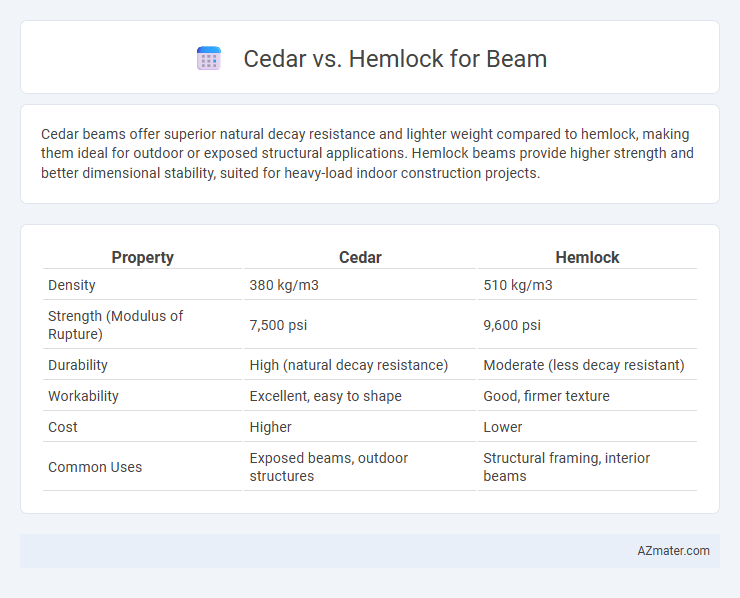Cedar beams offer superior natural decay resistance and lighter weight compared to hemlock, making them ideal for outdoor or exposed structural applications. Hemlock beams provide higher strength and better dimensional stability, suited for heavy-load indoor construction projects.
Table of Comparison
| Property | Cedar | Hemlock |
|---|---|---|
| Density | 380 kg/m3 | 510 kg/m3 |
| Strength (Modulus of Rupture) | 7,500 psi | 9,600 psi |
| Durability | High (natural decay resistance) | Moderate (less decay resistant) |
| Workability | Excellent, easy to shape | Good, firmer texture |
| Cost | Higher | Lower |
| Common Uses | Exposed beams, outdoor structures | Structural framing, interior beams |
Introduction: Cedar vs Hemlock for Beams
Cedar beams are prized for their natural resistance to decay and lightweight strength, making them ideal for both structural integrity and aesthetic appeal in construction. Hemlock beams offer a strong, durable option with a fine, even grain that enhances stability and ease of handling in framing applications. Comparing cedar and hemlock for beams involves balancing cedar's superior rot resistance against hemlock's economic availability and consistent performance.
Wood Species Overview: Cedar and Hemlock
Cedar offers a lightweight, decay-resistant wood species ideal for outdoor beams with natural oils that repel insects and moisture. Hemlock provides a strong, stable wood species favored for structural beams due to its straight grain and uniform texture, making it suitable for load-bearing applications. Both species balance durability and workability, but cedar excels in weather resistance while hemlock stands out for strength and dimensional stability.
Strength and Structural Performance
Hemlock beams offer superior strength and structural performance compared to cedar, with higher density and load-bearing capacity, making them ideal for heavy-duty construction. Cedar, while lighter and more resistant to decay, exhibits lower tensile and compressive strength, limiting its use in high-stress structural applications. Engineering-grade hemlock provides consistent stiffness and durability, ensuring long-term stability in beams subjected to significant loads.
Durability and Resistance to Decay
Cedar beams offer superior natural durability and decay resistance due to their high oil content, making them ideal for outdoor or moisture-prone applications. Western Hemlock, while strong and affordable, lacks natural oils and requires proper treatment to prevent decay and insect damage over time. Choosing cedar can reduce maintenance needs and prolong beam lifespan in environments exposed to weather and pests.
Moisture Resistance and Stability
Cedar offers superior moisture resistance due to its natural oils that repel water and reduce swelling, making it ideal for beams exposed to humid conditions. Hemlock, while structurally strong, has lower moisture resistance and is prone to warping and shrinkage when exposed to persistent dampness. The dimensional stability of cedar beams ensures long-term durability with minimal maintenance compared to hemlock alternatives.
Workability and Ease of Installation
Cedar beams offer superior workability due to their soft texture and uniform grain, making cutting and shaping easier for installers. Hemlock beams, while slightly harder, provide excellent strength and stability but may require more effort and specialized tools during installation. Both woods are lightweight, but cedar's natural resistance to splitting and warping enhances ease of installation and long-term performance.
Aesthetic Differences and Finishing Options
Cedar beams exhibit a rich reddish-brown hue with a natural, knotty grain that enhances rustic and traditional aesthetics, while Hemlock beams offer a lighter, creamy tan color with a straighter, more uniform grain ideal for modern and minimalist designs. Cedar's natural oils provide inherent resistance to decay and require minimal finishing, often allowing for a clear varnish or natural oil to highlight its warming tone. Hemlock, being less resinous, benefits from stain or paint finishes that add color while protecting the wood, making it versatile for customized interior styles.
Cost Comparison: Cedar vs Hemlock Beams
Cedar beams typically cost more than hemlock beams, with cedar prices averaging between $3 to $7 per board foot, while hemlock ranges from $2 to $5 per board foot. The higher cost of cedar is due to its natural resistance to decay and insects, reducing maintenance expenses over time. Hemlock beams, though more budget-friendly, may require additional treatment for durability, impacting long-term cost efficiency.
Environmental Impact and Sustainability
Cedar beams are sourced from fast-growing trees with a lower carbon footprint due to their natural resistance to decay, reducing the need for chemical treatments and frequent replacements. Hemlock, often harvested from sustainably managed forests, offers strength and durability but may require more treatment, impacting its environmental profile. Both woods contribute to sustainable construction when sourced responsibly, yet cedar's natural longevity provides a slight advantage in minimizing environmental impact over time.
Best Applications: Choosing the Right Wood for Your Project
Cedar offers excellent decay resistance and natural insect-repellent properties, making it ideal for outdoor beams exposed to weather and moisture. Hemlock provides superior strength and a uniform grain, which suits interior structural beams requiring high load-bearing capacity and a smooth finish. Selecting cedar or hemlock beams depends on whether durability in harsh environments or strength and aesthetic consistency in indoor settings is the priority.

Infographic: Cedar vs Hemlock for Beam
 azmater.com
azmater.com